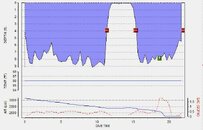Deefstes
Contributor
- Messages
- 1,396
- Reaction score
- 49
- # of dives
- 100 - 199
Hi all,
I've just logged dive number 4 with my Suunto Mosquito (dives 1-3 were just goofing off in a swimming pool so this is the first real dive). Now I'm getting to grips with the SDM software - I have version 2.6.0
First of all, the Mosquito is not air integrated but by entering the starting pressure and final pressure into the dive log, the software calculates my Surface Air Consumption (SAC) which is a handy value I guess. How it calculates this value I'm not so sure about though but more about that later. What I want to ask is what the pressure graph really means. There are two lines (blue for tank ressure and red for SAC). Here is a screen capture:

But two things about those two lines don't make sense to me. I would expect the blue line not to have an even gradient. I mean, assuming that I breath at the same rate throughout the dive, surely the tank pressure should drop at a quicker rate when I'm deeper down. The other thing is that the red line seems to be roughly inversely linked to the depth, in other words, as the dive gets shallower the SAC increases and as the dive gets deeper the SAC decreases. I would have thought that the deeper I am the higher my SAC would be and vice versa.
What is it that I'm not understanding?
Secondly, the way SDM calculates SAC baffles me a bit. Again, here is a screen capture of the air consumption page.

Apologies for using metric units but I live in the "rest of the world". By my calculations, if I use a 10 liter cyllinder filled to 210 bar (2100 liter) and I get out of the water with 60 bar remaining it means that I used up 150 bar, which multiplied by the 10 liters of cyllinder size gives me 1500 liters. Dividing this by 27 minutes gives me an air consumption of 15.56 liters per minute at depth. Dividing this by the average depth (11m) over 10 plus 1, gives me a SAC of 26.46 liters per minute but according to SDM my SAC is 23.5
I can already see where it's going wrong (or I'm going wrong). According to SDM, the "total gas in cyllinder" is 1981.1 liters (huh? this should be 2100 liters) and the "volume gas used" is 1374.5 (huh? this should be 1500).
Any ideas what's up here?
I've just logged dive number 4 with my Suunto Mosquito (dives 1-3 were just goofing off in a swimming pool so this is the first real dive). Now I'm getting to grips with the SDM software - I have version 2.6.0
First of all, the Mosquito is not air integrated but by entering the starting pressure and final pressure into the dive log, the software calculates my Surface Air Consumption (SAC) which is a handy value I guess. How it calculates this value I'm not so sure about though but more about that later. What I want to ask is what the pressure graph really means. There are two lines (blue for tank ressure and red for SAC). Here is a screen capture:

But two things about those two lines don't make sense to me. I would expect the blue line not to have an even gradient. I mean, assuming that I breath at the same rate throughout the dive, surely the tank pressure should drop at a quicker rate when I'm deeper down. The other thing is that the red line seems to be roughly inversely linked to the depth, in other words, as the dive gets shallower the SAC increases and as the dive gets deeper the SAC decreases. I would have thought that the deeper I am the higher my SAC would be and vice versa.
What is it that I'm not understanding?
Secondly, the way SDM calculates SAC baffles me a bit. Again, here is a screen capture of the air consumption page.

Apologies for using metric units but I live in the "rest of the world". By my calculations, if I use a 10 liter cyllinder filled to 210 bar (2100 liter) and I get out of the water with 60 bar remaining it means that I used up 150 bar, which multiplied by the 10 liters of cyllinder size gives me 1500 liters. Dividing this by 27 minutes gives me an air consumption of 15.56 liters per minute at depth. Dividing this by the average depth (11m) over 10 plus 1, gives me a SAC of 26.46 liters per minute but according to SDM my SAC is 23.5
I can already see where it's going wrong (or I'm going wrong). According to SDM, the "total gas in cyllinder" is 1981.1 liters (huh? this should be 2100 liters) and the "volume gas used" is 1374.5 (huh? this should be 1500).
Any ideas what's up here?






